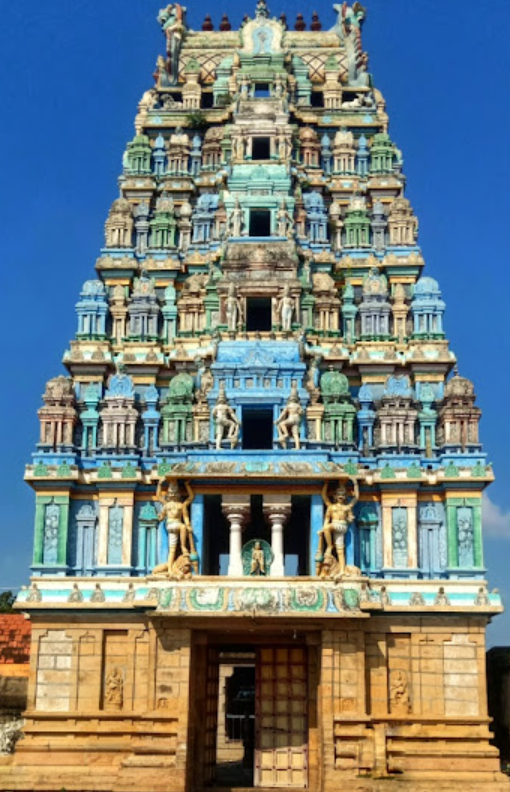The Kodi Kuzhagar Temple is believed to have been in existence since the 6th century CE, as it is referenced in the Devaram hymns by Tamil Saiva saints. The temple was completely reconstructed in granite during the 10th century CE.
Inscriptions within the temple provide evidence of its historical significance, with records dating back to the reigns of notable rulers, including Aditya Chola I (871–907 CE), Parantaka Chola I (907–955 CE), Rajaraja Chola I (985–1014 CE), Rajendra Chola I (1012–1044 CE), Kulothunga Chola I (1070–1120 CE), Rajaraja Chola III (1216–1246 CE), Rajendra Chola III (1246–1279 CE), Jadavarman Sundara Pandya (1250–1268 CE), and Jadavarman Parakrama Pandya (1169–1177 CE). These inscriptions primarily detail grants and renovations made to the temple.
The temple also received extensive patronage from the Pandya dynasty and the Nayak kings, contributing to its grandeur and upkeep. Currently, the temple is under the administration of the Hindu Religious and Endowment Board of the Government of Tamil Nadu, ensuring its preservation as a historical and spiritual landmark.
Puranic Significance 1 :
The Kodi Kuzhagar Temple holds a rich mythology and historical significance. During the churning of the ocean, the amritam (nectar), carried by Vayu in a pot, spilled when the asuras created a storm. A small quantity of this nectar fell at this location and took the form of a Lingam, giving the presiding deity the name Amritakadeswarar. Another spill of the nectar was collected by Murugan, who is revered here as Amrita Subrahmanyar, holding a pot. This unique depiction of Murugan makes him a significant deity in this temple, receiving special worship.
The temple also has a deep connection with the Ramayana. It is said that Rama, while planning to cross the seas to reach Lanka, sighted Lanka from this place. Sugreeva suggested building a bridge from here due to its proximity, but Rama declined, deeming it inappropriate to approach Lanka from the rear. Instead, Rama chose to build the bridge from Rameswaram, but not before praying to Lord Shiva at this temple. A shrine between this temple and the Agasthiyan Palli temple preserves and worships Rama’s footprint, marking his visit.
The temple’s history dates back to the 7th century CE, built during the Chola period. Saints Sambandar, Sundarar, and sage Kuzhagar worshipped here. It is said that Sundarar, accompanied by his friend Cheraman Peruman Nayanar, expressed anguish about the temple’s remote location, composing hymns questioning Lord Shiva’s choice of such a desolate place in the middle of a forest. The name Kodi Kuzhagar—derived from sage Kuzhagar and the Tamil word Kodi (meaning distant)—also reflects the temple's remote location during Chola times.
The temple is notable for its Navagraham arrangement, where all nine planets are aligned in a single row, facing the same direction, witnessing Shiva and Parvati in kalyana kolam. Inscriptions in the temple reference the reigns of Raja Raja Chola I, Rajendra Chola, and Kulothunga Chola, underscoring its historical prominence.
Saint Arunagirinathar has sung in praise of Lord Murugan here in his Tiruppugazh. The temple also features prominently in Kalki’s Ponniyin Selvan, as the temple near the lighthouse from which trips to Lanka were often undertaken.
Even today, the temple remains a serene, somewhat isolated spot in Tamil Nadu, preserving its mystical and historical legacy.
Puranic Significance 2 :
Kodiakadu, located along the sea route to Lanka, holds significant historical and mythological importance. It is believed that Sugriva initially proposed building a bridge from this location to Lanka to aid Lord Rama in his mission to defeat Ravana. However, Lord Rama disagreed with this plan, stating that attacking Ravana from behind would not be honorable. Instead, he chose Dhanushkodi, directly opposite the front entrance of Lanka. Before proceeding to Lanka, Lord Rama worshipped Lord Shiva at this temple. In remembrance of this event, Rama's footprints are carved here, and Lord Shiva is venerated as Amirtha Kadeswarar.
Administration History :
The administration history of the temple dates back to ancient times, with inscriptions from several dynasties, including the Cholas and Pandyas. The temple's original structure likely existed from the 6th century CE, with major reconstruction during the Chola period, especially in the 10th century CE, when it was rebuilt in granite. Inscriptions from rulers such as Aditya Chola I (871–907 CE), Parantaka Chola I (907–955 CE), Rajaraja Chola I (985–1014 CE), Rajendra Chola I (1012–1044 CE), Kulothunga Chola I (1070–1120 CE), Rajaraja Chola III (1216–1246 CE), Rajendra Chola III (1246–1279 CE), Jadavarman Sundara Pandya (1250–1268 CE), and Jadavarman Parakrama Pandya (1169–1177 CE) are found in the temple, detailing grants, endowments, and renovation activities throughout its history. The temple continued to receive extensive patronage from the Pandya and Nayak kings. Today, the temple is maintained and administered by the Hindu Religious and Endowment Board of the Government of Tamil Nadu, which oversees its operations, preservation, and development, ensuring the temple remains a significant cultural and religious site.
